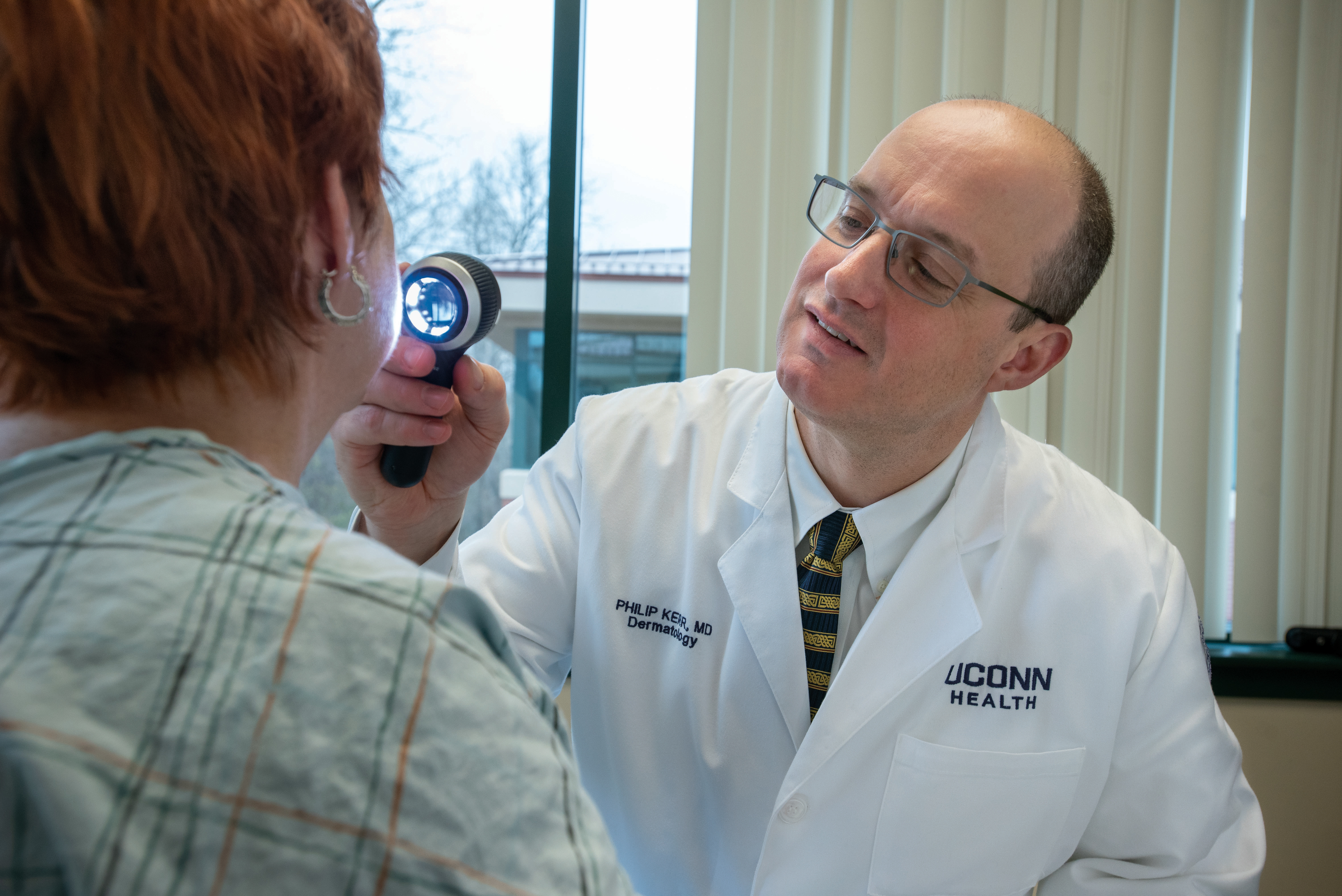As the sun and fun of summer begin, most people think of sun protection only when they spend a day at the lake, beach, or pool. However, sun exposure adds up day after day all year long.
It’s also the time of year we think more about skin cancer which is by far the most common type of cancer in the United States and worldwide. 1 in 5 Americans will develop skin cancer by the age of 70 and more than two people die of skin cancer in the U.S. every hour.

“We see people at our practice at UConn having sunburns during June more often than we do in July or August,” said Dr. Philip Kerr, Chair of Dermatology, UConn Health. He said the June sun is the strongest because the days are long and the sun is directly over us.
Most skin cancers are caused by too much exposure to ultraviolet (UV) rays. Most of this exposure comes from the sun, but some can come from man-made sources, such as indoor tanning beds and sun lamps. People who get a lot of exposure to UV rays are at greater risk for skin cancer.
The main types of UV rays that can affect your skin include UVA rays and UVB rays. UVB rays have more energy and are a more potent cause of at least some skin cancers, but both UVA and UVB rays can damage skin and cause skin cancer. There are no safe UV rays.
“Any color to the skin including a tan is the skin’s way of protecting itself from UV radiation by producing more melanin,” says Dr. Hao Feng, a Mohs micrographic surgeon and the Director of Laser Surgery and Cosmetic Dermatology at UConn Health.

Sunburn accelerates skin aging and is a leading cause in the majority of cases of basal cell carcinoma, squamous cell carcinoma, and melanoma, the deadliest form of skin cancer.
Basal cell carcinoma is the most common form of cancer worldwide. In the United States, it accounts for approximately 80 percent of all skin cancers. The majority of basal cell carcinomas are easily and successfully treated with current therapies.
According to Dr. Feng, basal cell carcinomas are most commonly found on the face, neck, ear, trunk, or other parts of the body that are frequently exposed to the sun. The cure rate for this type of cancer is very high at 99 percent when treated with Mohs micrographic surgery. However, because basal cell carcinomas often occur on the face, they can cause serious cosmetic damage and functional difficulties if not diagnosed and treated early.
Squamous cell carcinoma is the second most common form of skin cancer in the United States. It accounts for about 15 percent of all skin cancers. This type of cancer is also found around the face, the nose, top of ears, and the scalp are common places for skin cancer to develop due to exposure to the sun. While squamous cell carcinoma also has a high cure rate of 92-97 percent for tumors treated for the first time depending on the treatment modality, it generally does have a higher recurrence rate compared to basal cell carcinoma.
Melanoma is among the most serious forms of skin cancer. Most melanoma develops in the skin. The face, scalp, neck, arms, legs, chest, belly, and back are common areas where melanoma develops. Cutaneous melanoma can also start on the bed of a fingernail or toenail.
Kerr said he sees what sun damage and skin cancer does to people daily. Fair-skinned people with blue eyes, who freckly easily, are most at risk, but Kerr said they do see some cases in dark skin.
People who spend a lot of time in the sun or have a history of using tanning beds are at the highest risk for melanoma. But some people are at greater risk than others. The risk for melanoma also increases with age. When detected early, the 5-year survival rate for early stage melanoma is 99 percent, it is when it is found late and has spread to other parts of the body that it can cause death.
“Skin cancer is common and prevention is the key to not only preventing skin cancer but skin health in general to prevent healthy aging,” says Feng.
Kerr says sunscreen is the first line of defense against skin cancer and said it needs to be done properly.
“If a person’s going to be out for more than two hours, then we recommend to reapply, and also we recommend to reapply if someone has been in a swimming pool or the ocean for more than five or 10 minutes.”
He recommends a 30 SPF for those going to be out for under two hours and 50 if longer or near water. “The reason is that water reflects the ultraviolet up towards us,” he explained. That means getting sun from overhead and below from the water’s reflection.
“The frequency and amount of application is an important part of using sunscreen,” says Feng. Not applying enough or frequently enough is a common mistake when using sunscreen.
- Apply 15 minutes before you go outside. This allows the sunscreen (of SPF 30 or higher) to have enough time to provide the maximum benefit.
- Use enough to cover your entire face and body (avoiding the eyes and mouth). An average-sized adult or child needs at least one ounce of sunscreen (about the amount it takes to fill a shot glass) to evenly cover the body from head to toe.
- Know your skin. Fair-skinned people are more susceptible to the damaging effects of the UV rays than dark-skinned people under the same conditions.
- Reapply at least every two hours, and more often if you’re swimming or sweating.
Kerr said the single best ingredient in sunscreen is zinc oxide. He said it lasts longer and “doesn’t absorb into the bloodstream. We know that the chemical-based sunscreens do absorb into the body and are found in the bloodstream.”
Some key sun safety tips include:
- Limit time in the sun, especially between the hours of 10 a.m. and 2 p.m., when the sun’s rays are most intense.
- Wear clothing to cover skin exposed to the sun, such as long-sleeved shirts, pants, sunglasses, and broad-brimmed hats.
- Use broad-spectrum sunscreens with SPF values of 30 or higher regularly and as directed.
- Reapply sunscreen at least every two hours, and more often if you’re sweating or jumping in and out of the water.
There is no such thing as a base tan to protect you. For a sun-kissed look, you can consider tanning gels and lotions or spray tans. These are safer options, however, they don’t provide protection from the sun’s damaging rays.
It’s never too late to protect your skin from damage. You and your dermatologist can determine based on you and your family’s health history how often you should be checked for skin cancer.
To learn more or set up an appointment visit UConn Dermatology or call 860-679-4600.



